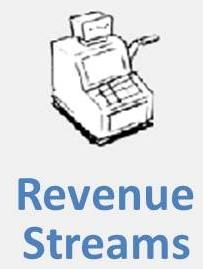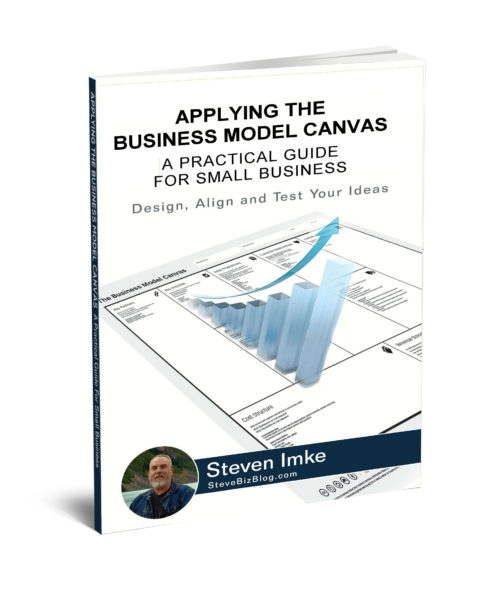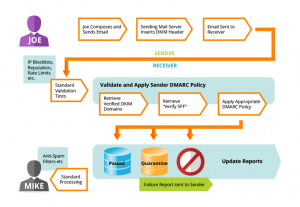— July 18, 2019

When it comes to choosing revenue streams as part of the overall Business Model Canvas, there are many factors that affect your sources of revenue.
Pricing Mechanisms
Your first consideration when defining your revenue streams is to give some thought to your general pricing mechanisms. Your pricing mechanism can be either to employ fixed pricing or a form of dynamic pricing for your product or service.
Fixed Pricing
When it comes to defining fixed pricing, do you only offer just a single list price, like a restaurant menu? Or do you offer customer segment pricing which features different prices based on specific customers, such as offering reduced prices for seniors or veterans? Finally, do you offer volume-dependent pricing where you provide discount pricing if the customer buys in bulk? In all fixed pricing situations, you have a defined price for your product or service based on a set of defined rules.
Dynamic Pricing
In addition to the more traditional fixed pricing mechanism, your revenue streams may come through a dynamic pricing mechanism. One form of dynamic pricing might be negotiated pricing, such as buying a car or home where the final price is negotiable. Another form of dynamic pricing is yield management pricing, where the price changes based upon your inventory, like airline ticket prices changing based on the time left and how many available seats are yet unsold. Real-time market pricing is defined by supply and demand factor, like how stocks or commodities go up and down. Lastly, you might offer pricing based on an auction price through a bidding process, similar to how buyers make a purchase on platforms like eBay.
Transactional or Reoccurring Revenue Streams
Your next major consideration is to determine if your revenue will come from a single transaction or reoccurring transactions When you have a revenue stream based on a single transaction, you receive a single one-time payment for your product or service. However, when you have a reoccurring revenue stream, you receive ongoing payments that deliver value or provide post-sales support to your customers.
An important consideration when deciding between a transactional or reoccurring revenue stream is related to your cost of customer acquisition. For a single transaction, your customer acquisition costs are spread across just one transaction opposed to a recurring transaction, where your customer acquisition costs are spread across many transactions.
Fee-Based Revenue Streams
When you sell a product like a car or furniture, the customer is buying a physical asset. Once it is owned by the consumer, they are free to do whatever they want with it. They can use it or sell it without your permission. However, there are a bunch of other revenue streams that are fee-based revenue streams. With fee-based revenue streams, the business continues to own the underlining asset and gives permission to the customer to use it.
Here are some common examples of fee-based revenue streams you may want to consider for your business.
Usage Fees
The more they are used, the more the customer pays the business. ATM charges are one example of a usage fee. Every time you use an ATM machine, the bank charges you a fee. The more you use ATMs, the more the bank changes you. Another example is a cell phone data plan. The wireless carrier charges the customer a usage fee based on the amount of data they used. Usage fees represent a variable but recurring revenue to the business.
Subscription Fees
Revenue is generated by continuing to provide access to a service. Fitness centers have a monthly subscription plan to continue to provide the user access to the gym. Netflix charges a monthly subscription fee to provide continued access to its online streaming video service. With a subscription fee, the user is granted unlimited access to the service during the subscription period. Whether you use it a little or a lot, the subscription fee is the same price. Subscription fees represent a consistent reoccurring source of revenue to the business.
Lending/Renting/Leasing
Revenue is generated by temporarily granting exclusive rights to use an asset for a fixed period of time. When you rent a car, the rental agency gives you exclusive use of the vehicle for the term of the rental agreement, and no one else can use the asset while it is assigned to the customer. However, once the period is over the asset can be assigned to another customer, and the customer has no ownership of the product during the term besides the exclusive right to use it. Lending, renting, and leasing can be either transactional or recurring revenue, and represent a consistent source of income for the period of the agreement.
Licensing
Revenue is generated by giving the customer permission to use protected intellectual property and allowing the customer the right to generate revenue from the property. Patent holders often license their ideas to a manufacturer in exchange for a fixed fee or a royalty on all sales. Licensing can be either transactional or recurring revenue.
Brokerage Fees
Revenue is generated by an intermediary service performed between two or more parties. A credit card company collects a brokerage fee by connecting the merchant to the customer. The credit card company owns nothing, they just facilitate the transaction. Another example of a brokerage fee is when a real estate broker captures a commission for matching a buyer and a seller. Brokerage fees are typically transactional revenue.
Advertising Fees
Revenue is generated from fees charged to a third party to present a message to your customers. Advertising can be either transactional or recurring revenue.
Financing Fees
Revenue in the form of interest is generated by selling either an asset or a service to a customer, and then extending credit to the customer so that they can pay for the purchase over a period of time.
Revenue Stream Questions
While there are many options that you can employ to generate revenue for a business, there are several questions that you should ask yourself when choosing the best options for your business:
- For what value are your customers really willing to pay?
- What do they currently pay?
- How are they currently paying?
- How would they prefer to pay?
- How much does each revenue stream contribute to your overall business revenue?
When it comes to your revenue streams, do you have a clear picture of all the ways you can generate revenue?

Applying the Business Model Canvas, A Practical Guide For Small Business is a book that was written for the entrepreneur trying to come up with a workable new business model. By using the Socratic method of asking and answering questions for each of the 13 building blocks of the Business Model Canvas and the Value Proposition Model. The reader will be able to turn abstract ideas into a practical business model in no time. The book is a concise and easy to read guide packed with solid advice and examples that will help you refine your new business ideas before you launch helping you avoid costly mistakes.
Business & Finance Articles on Business 2 Community
(75)







